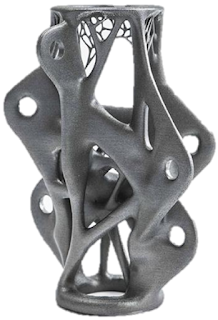Definition and Principles of Topology Optimisation
Definition
and Principles of Topology Optimisation
- Topology
Topology is the
mathematical study of a geometry proprieties that are unaltered by changes in
the size or shape of geometric figures under elastic deformations, as bending
or stretching (Dictionary.com, n.d.;
Oxford Dictionaries, n.d.). For this reason, it is
often called rubber-sheet geometry (Mohammed, 2004). In topology, a donut
and a coffee cup with a handle are equivalent shapes, because each has a single
hole (The American Heritage®
Science Dictionary, n.d.) (Figure 1).
 |
Figure 1 - The geometries (a), (b) and (c) have different topology. But, the geometries (I) created by (a), have the same topology. The same between (b) and (II), and the same between (c) and (III).
- Topology Optimisation
Topology Optimisation (TO) is a technique
to generate a material distribution to better answer to an optimisation
objective under some initial geometry boundary and a set of constraints, being
most of them, physical constraints. Different from FEM, that can be seen as a
passive simulation tool, in which a previous geometry must be generated to
perform the analysis. The TO is an active tool, in the sense of it will create
a geometry according to the design conditions to can be post analysed. The
material is placed following the forces flow into the design space, allowing
designers and engineers to identify the load paths in the part.
Basicaly, TO problems
can be treated by shape optimisation (using Lagrangian with boundary following
mesh) or as a density approach (using Eulerian with fixed mesh) (Sigmund & Maute,
2013). There is a large
number of mathematical schemes to solve these problems. Will be discussed next,
some of the most popular and well known in the literature and used in software.
In density approach, the
TO solves a structural problem in which the design domain is initially
discretised in n elements (defined as
a discrete problem). The aim is to the TO algorithmic interactively decides,
based on gradient information, where to place material and where to remove in
each cell created by the discretisation, to satisfy the objectives functions
and to respect all constraints. During interactions, the solver search for
low-stress regions and place into that, elements with a lower equivalent
density, to next analyse the behaviour of the remained structure. This
discretisation is performed by Finit Elements Methods (FEM)[1] (Figure 2).
Approaches based on the
idea of discretisation and selection of cells with or without material are
called of Element Based Methods (Dunning, Brampton,
& Kim, 2015). This problem is
mathematically formulated as a non-linear mixed 0-1 problem. Each element can
have the material density 1 (material) or 0 (void). However, discrete problems
are difficult and inefficient to solve and to contour this inconvenience, it is
relaxed in which the amount of material in each element can continuously vary
from 0 to 1 density, in which the intermediate density represents fictitious
material. The reason that this formulation is called for Density Approach. The
material stiffness is considered as linearly dependent of the density (Altair University,
2015). Nevertheless, one
problem with the Density Approach is that the solution at convergence often
exhibits several grey-scale elements (intermediate density). Unless an advanced
manufacturing process is used, such as Additive Manufacturing, capable of
making infills volume with different fractions, the grey elements are not
desirable to the most of common manufacturing processes, that need a uniform
density, such as moulding (Nobel-Jørgensen &
Bærentzen, 2016). To have an approximate
behaviour to the discrete problem and to reduce the occurrence of intermediate
density elements, density values are induced to become 1 or 0. This is called
of Penalisation, and a value of penalisation factor (depending on the
representation of elasticity properties, is usually higher than 1) is used to
move these intermediate densities to the extremes (0 or 1). One of the most
used methods is the Simplified Isotropic Material with Penalization (SIMP). The
SIMP can have variants with an implementation of filters, bringing additional
benefits, such as the elimination of checkerboard patterns for instance (Figure 3).
 |
| Figure 3 - Example of filters implementations in SIMP method. In (a) is possible to verify a dominant presence of checkerboards. FONT: (Sigmund, 2007). |
Another alternatives
method to SIMP have been developed, such as Rational Approximation of Material
Properties (RAMP) and methods based on homogenisation of microstructures.
Another element based
method that does not use penalisation, working directly with 0 or 1 densities
is the Bidirectional Evolutionary Structural Optimisation, that uses heuristic
criteria to removes or adds material (Dunning et al., 2015)
Element based methods
have demanded improvement to avoid numerical issues such as mesh dependent
solutions, checkerboard patterns, rough surfaces etc. Most of them leading to
the need for post-treatment of geometries. Some of the inconveniences of this
post-treatment are the time spent to perform the corrections, and the risk of
lost the benefits gain in the optimised geometry. To avoid these issues, have
been developed Boundary Based Methods as an alternative (Dunning et al., 2015).
Altair University. (2015).
Practical Aspects of Structural Optimization.
Dictionary.com. (n.d.). Topology. Retrieved April 8,
2018, from http://www.dictionary.com/browse/topology
Dunning, P. D., Brampton, C. J., & Kim, H. A.
(2015). Simultaneous optimisation of structural topology and material grading
using level set method. Materials Science and Technology, 31(8),
884–894. https://doi.org/10.1179/1743284715Y.0000000022
Mohammed, A. (2004). Homogenization and structural
topology optimization of constrained layer damping treatments.
Nobel-Jørgensen, M., & Bærentzen, J. A. (2016).
Interactive Topology Optimization.
Oxford Dictionaries. (n.d.). Topology. Retrieved April
8, 2018, from https://en.oxforddictionaries.com/definition/topology
Sigmund, O. (2007). Morphology-based black and white
filters for topology optimization. Structural and Multidisciplinary
Optimization, 33(4–5), 401–424.
https://doi.org/10.1007/s00158-006-0087-x
Sigmund, O., & Maute, K. (2013). Topology
optimization approaches: A comparative review. Structural and
Multidisciplinary Optimization, 48(6), 1031–1055.
https://doi.org/10.1007/s00158-013-0978-6
The American Heritage® Science Dictionary. (n.d.).
Topology. Retrieved April 8, 2018, from
http://www.dictionary.com/browse/topology
[1] New TO techniques are
emerging in which is possible to skip the FEM discretisation, usually based on
IGA technology.



Comments
Post a Comment